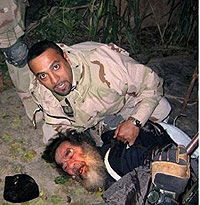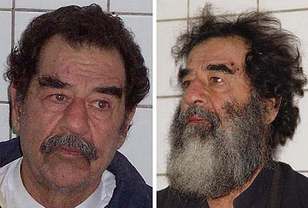The Iraq War
Saddam Hussein Captured
December 13th, 2003
Saddam Hussein, the President of Iraq from 1979 until 2003, was captured by US forces on December 13th, 2003, on the outskirts of the town of ad-Dawr. Ad-Dawr is less than twenty kilometers from Saddam’s hometown of al-Awja. US forces had questioned many of his extended family members and finally received a tip. He was found hiding in a small, concealed hole with a ventilation vent that allowed him to remain in it for days, armed with a pistol. Because of his status as the leader of the old regime’s military forces, he was taken as a prisoner of war and granted all the rights given under the Geneva Convention. Reactions among Iraqis were varied, with many Shiites celebrating wildly and some of his supporters continuing to declare their support for him. In Fallujah, his supporters waved rifles defiantly, and a day later in Baghdad, two massive car bombs went off, presumably targeted at new recruits joining the new Iraqi police force.
Saddam Hussein’s capture was viewed by most of the international community as a sign that change in Iraq was at hand. Tony Blair, Prime Minister of the United Kingdom at the time, stated that it “remove[d] the shadow that has been hanging over [the Iraqi people] for too long of the nightmare of a return to the Saddam regime”. That regime caused untold horrors among his own people as well as those of other states. In 1988, Saddam had the Kurdish town of Halabja attacked with mustard gas and nerve agents, killing five thousand civilians, in 1990 he invaded Kuwait, setting of the Gulf War.
In retrospect, Saddam Hussein’s capture did little to stifle the violence and resistance in Iraq, sectarian violence and insurgency continued unabated. It was, however, a significant symbolic victory for the US.
Saddam Hussein’s capture was viewed by most of the international community as a sign that change in Iraq was at hand. Tony Blair, Prime Minister of the United Kingdom at the time, stated that it “remove[d] the shadow that has been hanging over [the Iraqi people] for too long of the nightmare of a return to the Saddam regime”. That regime caused untold horrors among his own people as well as those of other states. In 1988, Saddam had the Kurdish town of Halabja attacked with mustard gas and nerve agents, killing five thousand civilians, in 1990 he invaded Kuwait, setting of the Gulf War.
In retrospect, Saddam Hussein’s capture did little to stifle the violence and resistance in Iraq, sectarian violence and insurgency continued unabated. It was, however, a significant symbolic victory for the US.


